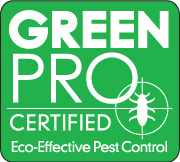GreenPro Certified Pest Control
Serving Illinois and Indiana
The Anderson Approach
Anderson has received GreenPro certification from the National Pest Management Association (NPMA). The GreenPro program is the most widely recognized green certification program for pest management professionals in the world, and is the only program of its kind to have received an award from the Environmental Protection Agency.
 Our new GreenPro designation means that we comply with the procedures and systems established by the NPMA’s GreenPro Committee to ensure that our customers receive responsible, eco-effective service. In addition to requiring participating companies to submit independent audits, GreenPro certified companies must have all service technicians, salespersons and managers trained, tested and re-certified. GreenPro certified companies are also evaluated on business operations, such as criminal background checks, reference checks, drug screening and more, prior to being allowed to participate in GreenPro.
Our new GreenPro designation means that we comply with the procedures and systems established by the NPMA’s GreenPro Committee to ensure that our customers receive responsible, eco-effective service. In addition to requiring participating companies to submit independent audits, GreenPro certified companies must have all service technicians, salespersons and managers trained, tested and re-certified. GreenPro certified companies are also evaluated on business operations, such as criminal background checks, reference checks, drug screening and more, prior to being allowed to participate in GreenPro.
Green Standards
GreenPro compliance means that Anderson provides its customers with a comprehensive green approach that includes the implementation of an integrated pest management (IPM) program. IPM is a long-standing, science-based, decision-making process that identifies and reduces risks from pests and pest management strategies. It coordinates the use of pest biology, environmental information, and available technology to prevent unacceptable pest levels by the most economical means, while posing the least possible risk to people, property, resources and the environment.
IPM is the cornerstone of complying with the “green service standards” of GreenPro. Integrated pest management is a multi-step process that guides pest management professionals toward efficient, effective, and sustainable pest management that emphasizes pest prevention and non-chemical methods. This decision-making process backed up by thorough monitoring, record-keeping, integration of a variety of control strategies and customer communications are the principal characteristics of IPM.
A structural IPM program emphasizes three fundamental elements:
1. Pest Prevention
IPM is a preventive maintenance process that seeks to suppress pest reproduction and to identify and eliminate potential pest access, shelter/habitat, and availability of food and water. Monitoring on a continual basis for pests and pest conducive conditions is conducted in order to identify problem areas and prevent small infestations from becoming large ones. Pest management professionals (PMPs) must use management practices to prevent pests which include, but are not limited to:
- Customer education.
- Removal of pest habitat, sources of food and water, and breeding areas or recommendations to the customer/client on steps they should take to eliminate sources of food, water or breeding areas.
- Prevention of access to structures or recommendations to the customer/client on steps they should take to modify the structure to eliminate pest access to the structure.
- Management of environmental factors, such as temperature, light, humidity, atmosphere, and air circulation, to prevent pest reproduction and serve as a deterrent to pest infestation.
2. Multiple Management Strategies and Tools
A variety of pest control strategies and tools are integrated into a comprehensive program to manage the pest. Management strategies may include, but are not limited to, the following:
- Providing the customer with information about behaviors, conditions, and policies that allow pests access to the site, food, water, and habitat.
- Mechanical or physical controls including, but not limited to, traps, vacuuming, steam cleaning, or physical barriers.
- Horticultural controls including, but not limited to, changing irrigation practices, treatment or removal of plants attracting pests and/or providing access to structures.
- If preventive measures are insufficient to prevent or control pests, chemical controls may be used. Chemical controls must be applied according to GreenPro pesticide application standards.
3. Systems Approach
Pest management must take into account and be effectively coordinated with other relevant activities and programs that operate in and around a building. Whenever possible, a pest management perspective should be incorporated in procedures and plans involving cleaning, waste management, food service and handling, storage, repair and alteration, and design and construction. In order to accomplish this, the Pest Management Professional must form a partnership with the customer to provide education on pest management issues and to gain cooperation.
The NPMA’s GreenPro program recently received the National Pesticide Program Partners Award from the Environmental Protection Agency (EPA). The award was given as a part of EPA’s Office of Pesticide Program’s first-ever Honor Awards Ceremony, which aims to highlight core values and principles of EPA and encourage their widespread practice.
We’re very proud to have achieved GreenPro certified status. Though being certified as a “green” service provider is a popular issue these days, we’ve actually been practicing the same environmentally responsible procedures required by GreenPro in our service for many years. There were very few changes we made in order to be compliant with the GreenPro standards. The real benefit is that our customers now have an even better way to know which pest solutions companies are responsible – and which aren’t. There are a lot of pest management companies that say that they’re “green” but haven’t implemented environmentally-responsible practices, don’t stress preventative measures, and don’t use the GreenPro systems approach. We believe that once customers understand the difference, they’ll see that Anderson is the natural choice for pest management service.



